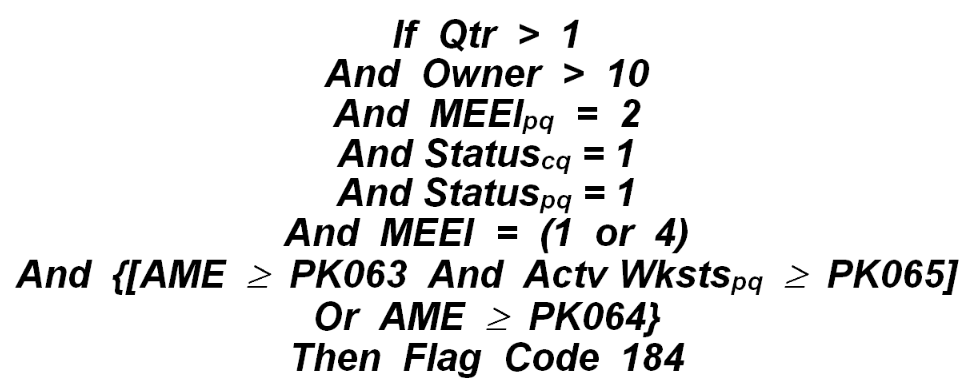11 code 184 large multi ceases breakout check
Large Multi Ceases Breakout Check - Code 184
Although this edit is the highest numbered of the multi-balance warning conditions (normally indicating the least significant exception), it relates to one of the more cataclysmic situations for a multi-family. This edit checks for a “mega collapse,” taking a very large family to single-account filing status. In addition, this edit only applies to non-standard, mid-year discontinuation of breakout data, which is seldom seen. Coding for this edit is shown below. It notes that a multi-unit reporter must have had prior summed employment or current single employment in the hundreds (PK064), or that there be not quite as much employment (PK063), but originally possessing at least 50 reporting units (PK065) in the original multi-unit families. This is indeed a rare combination.
Federal employers are exempt from this edit, as are those that have gone to an MEEI code of ‘6’ (low-employment non-breakout), even though the original employment might have been in the thousands, and the new MEEI was miscoded. The mid-year mega-collapse formulation is:
The pq and cq subscripts show prior quarter and current quarter data, respectively. The edit tolerances are shown with the PK values that were explained previously. The Actv Wksts notation refers to the count of worksite sub units that showed an active status code during the prior quarter. A set of braces and square brackets are used to distinguish the two sides of the “Or” condition (a many-worksite family that terminated with high ending employment, or very-high-employment new single with a not-necessarily-big former family). Once again, since this edit ignores the first calendar quarter for collapsed families, these mid-year collapses are unusual cases. This warning message can also be considered a “gross” error, depending on the size of the family’s employment and/or wages. BLS classification: A.2.8 or B.2.9, based on family employment or wage size.
Related Links
